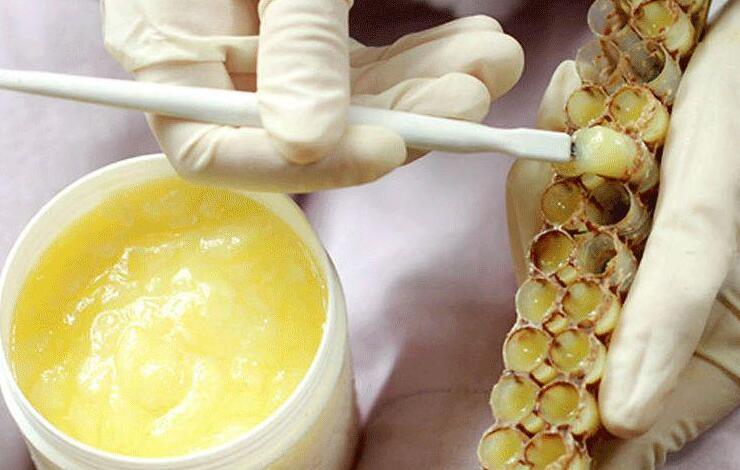The formation of royal jelly
1. Royal jelly is produced by worker bees. There is a unique royal jelly on the abdomen of worker bees. The substance secreted by the royal jelly is the main body of royal jelly, which is the main source of protein in royal jelly.
2. The queen gland exists on the head of the worker bee. After it produces secretions, it will pass through the duct to the bottom of the bee’s mouth. At this time, some secretions produced by the maxillary glands will also be mixed into it. Secretions are the main source of fatty acids in royal jelly.
3. From the above introduction, it can be seen that royal jelly is actually a mixture of the secretion of the queen gland and the maxillary gland of the worker bees. However, this secretion can only be produced by worker bees at the age of five to fifteen days. Other worker bees do not have this kind of secretion. Function exists.
The role of royal jelly in the colony
Royal jelly plays an important role in the development of the colony. It is the lifelong food of the queen bee in the colony, and an important nutrient component to help the queen bee lay eggs. In addition, the royal jelly is also the food for all the larvae in the colony, but these larvae are just the colony. For bee larvae within three days of age, no matter how large the larvae are, there is no royal jelly to eat.
The chemical composition of royal jelly
Bee jelly (royal jelly and honey are formulated in proportion to the food, which can effectively extend the preservation time of royal jelly). It contains protein, fat, carbohydrate, vitamin A, vitamin Bl, vitamin B2, rich folic acid, pantothenic acid and inositol. There are also substances similar to acetylcholine, as well as a variety of amino acids and biological hormones required by the human body.
Royal jelly is a kind of bee product with quite complex components. Its chemical composition varies with bee species, age, season, and pollen plants. Generally speaking, its ingredients are: water 64.5-69.5%, crude protein 11-14.5%, carbohydrates 13-15%, lipids 6.0%, minerals 0.4-2%, undetermined substances 2.84-3.0%.
Protein accounts for about 50% of the dry matter of royal jelly, of which 2/3 is albumin and 1/3 is globulin. There are more than 12 kinds of proteins in royal jelly, in addition to many small peptides.
Amino acids account for about 1.8% of the dry weight of royal jelly. The eight essential amino acids required by the human body are all present in royal jelly. Among them, the highest content of proline accounts for about 63% of the amino acids.
Royal jelly contains nucleic acid, of which deoxyribonucleic acid (DNA) 201-223 microgram/gram is significant weight, and ribonucleic acid is 3.9-4.9 mg/gram significant weight.
Royal jelly contains 20%-30% (dry weight) of sugars, which roughly contains 52% fructose, 45% glucose, 1% sucrose, 1% maltose, and 1% gentiobiose.
Royal jelly contains more vitamins, especially B vitamins. In addition, there are mainly: thiamine (B1), riboflavin (B2), pyridoxine (B6), vitamin B12, niacin, pantothenic acid, folic acid, biotin, inositol, vitamin C, vitamin D, etc., among which pantothenic acid The highest content.
Royal jelly contains more than 26 fatty acids, 12 of which have been identified. They are 10-hydroxy-2-decenoic acid (10-HDA), decanoic acid, nonanoic acid, undecanoic acid, dodecanoic acid, and decanoic acid. Tetradecanoic acid (myristic acid), myristic acid, palmitic acid (palmitic acid), octadecanoic acid, palmitoleic acid, arachidic acid and linoleic acid, etc., of which 10-hydroxy-2-decenoic acid , The content is more than 1.4%. Since only royal jelly contains this substance in nature, it is also called royal jelly acid.
Royal jelly contains 9 sterol compounds, three of which have been identified, they are stigmasterol, cholesterol and sitosterol. It also contains minerals such as iron, copper, magnesium, zinc, potassium, and sodium.
The nutritional value of royal jelly
1. Royal jelly is high in protein, and protein accounts for about 50% of the dry matter of royal jelly, of which 2/3 is albumin and 1/3 is globulin. There are more than 12 kinds of proteins in royal jelly, in addition to many small peptides.
2. Royal jelly also contains fat, carbohydrates and acetylcholine-like substances, as well as a variety of amino acids and biological hormones required by the human body.
3. Royal jelly contains 9 kinds of sterol compounds, of which three have been identified. They are stigmasterol, cholesterol and sitosterol. It also contains minerals such as iron, copper, magnesium, zinc, potassium, and sodium.
4. Royal jelly contains vitamin A and vitamin B, especially rich in B vitamins. In addition, there are mainly thiamine (B1), riboflavin (B2), pyridoxine (B6), vitamin B12, niacin, pantothenic acid, folic acid, biotin, inositol, vitamin C, vitamin D, etc. The content of pantothenic acid highest.
Royal jelly contains vitamin A and vitamin B
5. It has been found that royal jelly is rich in proteins (such as albumin, a protein, b protein, impermeable protein), and its protein active ingredients can be divided into three categories, namely insulin-like, active polypeptide and g-globulin. It has the function of adjusting the body’s metabolism and improving the body’s immunity.
6. Royal jelly contains more than 20 kinds of amino acids. The higher content is lysine, glycine, glutamic acid, etc. Among them, 8 kinds of amino acids cannot be synthesized by the human body and must be ingested from food.
7. Royal jelly contains a lot of vitamins, of which vitamin B group is the most abundant, and the others are folic acid, pantothenic acid, inositol, vitamins
The function of royal jelly
main effect
1. Help lower blood sugar. This effect is mainly inferred from the insulin-like peptides it contains, which are specific drugs for the treatment of diabetes. Experiments show that 10 grams of royal jelly per day combined with Lin Zhongling can treat diabetes and insomnia.
2. Antioxidant effect. This effect is a universally recognized effect of royal jelly, and it has a strong effect on cell repair and regeneration. The superoxide dismutase (SOD) detected in royal jelly is the main antioxidant component.
3. Lower blood lipids. Royal jelly contains more than 10 vitamins necessary for the human body, can balance fat metabolism and sugar metabolism, and can reduce hyperlipidemia and hyperglycemia in obese people. It is very suitable for obese diabetic patients.
4. Control vasodilation and lower blood pressure. This conclusion comes from the 10-hydroxy-decenoic acid (Royal Jelly Acid) and the major protein-1 of Royal Jelly.
5. Protect the liver. Royal jelly can not only kill the hepatitis virus, but also inhibit the replication of the virus in liver cells. The flavonoids in propolis have the effect of reducing transaminase, promoting liver cell regeneration and preventing liver cirrhosis. Such patients are not suitable for taking alcohol-containing propolis products, but should take non-alcoholic propolis soft capsules or Concentrate.
6. Antibacterial and anti-inflammatory. Royal jelly has antibacterial effects and promotes healing of wound infections. Tests also showed that the antibacterial spectrum of royal jelly is Escherichia coli, Staphylococcus aureus, Streptococcus, Proteus, Bacillus subtilis, Mycobacterium tuberculosis, Trichophyton stellate and Epidermophyton. The antibacterial and anti-inflammatory effects of royal jelly are related to pH. When the pH is 4.5, the antibacterial properties are strongest, when the pH is 7, the antibacterial properties are weakened, and when the pH is 8, the antibacterial properties disappear. The pH of royal jelly is between 3.5 and 4.5. Therefore, under natural conditions, it has the strongest antibacterial and anti-inflammatory properties.
7. Anti-aging and strengthening sexual function, as well as anti-radiation and enhancing memory.
Ten effects
Nutritionists believe that royal jelly is a super nutritious food with high active ingredients that can be taken directly by humans. The medical professionals in the United States, Britain, France, Germany, Italy, Japan and other countries have summarized the ten major effects of royal jelly:
Fresh royal jelly contains a certain amount of acetylcholine, which can play a health care effect on the human nervous system;
Royal jelly is rich in vitamin B and high-quality protein, especially royal jelly acid with strong bactericidal power, so it is a good medicine for cancer;
Royal jelly can promote hematopoietic function, increase hemoglobin, promote growth and improve disease resistance;
Royal jelly contains pantothenic acid, which can improve rheumatism and joint symptoms.
Royal jelly contains insulin-like peptides, the molecular weight of which is the same as bovine insulin, which has a good function of regulating the islet function of diabetic patients;
Royal jelly can strengthen the function of the adrenal cortex, regulate human hormones, activate diencephalon cells, and help treat menopausal disorders and chronic prostate inflammation.
Royal jelly can enhance the basic physical strength of the human body, activate the aging tissues of the human body, have a good appetite, increase energy, and look good after taking it.
The peptides and proteins contained in royal jelly can promote intellectual development, so taking it can improve memory.
Royal jelly contains protein hormones and natural antibiotics. When applied to treat burns, it can prevent infection, promote cell production, and leave no scars after healing;
Royal jelly contains a variety of inorganic salts, which can promote the release of glycogen and promote metabolism, so it can beautify and eliminate spots.
Royal jelly has a good effect of regulating blood lipids.
Regarding the dosage of royal jelly, it should be determined according to different needs. Adults take 2 to 5 grams of nutrition and beauty daily, about 10 grams for disease prevention and health care, and 20 grams for treatment of serious diseases.
Pharmacological action
Many years of scientific research and medical clinical practice at home and abroad have proved that royal jelly has peculiar effects on human medical treatment and health care.
(1) Improve nutrition and replenish brain power: Royal jelly contains a lot of nutrients. Regular consumption can improve malnutrition, treat loss of appetite and indigestion, strengthen people’s physical and mental power, and improve mood.
(2) Improve human immunity: Royal jelly contains immunoglobulins, which can significantly improve human immunity. After eating royal jelly for a period of time, people obviously feel energetic and the chance of catching colds and other diseases is reduced.
(3) Prevention and treatment of cardiovascular and cerebrovascular diseases: Long-term use of royal jelly has a good effect on patients with trilipidemia, vascular sclerosis, arrhythmia, diabetes and other diseases.
(4) Treatment of anemia: Royal jelly contains copper, iron and other substances that synthesize hemoglobin, which has a strong hematopoietic system and excites bone marrow hematopoietic function. It has been clinically used to assist in the treatment of anemia and other diseases.
(5) Anti-inflammatory, analgesic, and promote wound healing: 10-HDA in royal jelly, that is, royal jelly acid has antibacterial, anti-inflammatory and analgesic effects, and can inhibit the growth of more than ten kinds of bacteria such as Escherichia coli, pyogenes, epidermophytes, and tuberculosis . In clinical medicine, royal jelly and honey are used to prepare topical gauze, which is used for burns, frostbite, surgery and anal wounds. The effect of analgesic, anti-inflammatory, improved blood circulation and nutrition on the wound is significantly better than Vaseline and other topical gauze.
(6) Cancer prevention: Experiments have shown that royal jelly can inhibit the spread of cancer cells and cause degenerative changes in the development of cancer cells, which has a good preventive effect on cancer.
(7) Royal jelly is a very good cosmetic agent: Royal jelly is rich in vitamins and proteins, it also contains SOD enzyme, and has a sterilization effect. It is a precious beauty product, long-term use, the skin is ruddy, shiny and beautiful .
(8) Enhance appetite and absorptive capacity: regulate liver and gastrointestinal functions.
(9) Treatment of menopausal syndrome
Menopause is a physiological stage that the human body must go through. Most people have no obvious symptoms during this period. However, some women have some symptoms in the cardiovascular system, nervous system, mentality, metabolism and other aspects of menopause (40-55 years old), which are collectively called menopausal syndrome. As for the cause, it is generally believed that when the human body reaches a certain age, the ovaries decline, the hormones secreted by the ovaries decrease, and they lose feedback on the hypothalamus-pituitary, resulting in hyperpituitary function, affecting various endocrine system dysfunctions, and causing cardiovascular system failure. Stability, metabolic disorders, autonomic nervous system disorders, etc. But there are also different explanations, and this issue still needs further study.
Keiichi Matsushita, a Japanese medical doctor, discovered through a large number of clinical observations and eating cases that royal jelly has obvious effects on menopausal syndrome. Middle-aged and elderly people taking royal jelly can not only delay the arrival of menopause, but also can significantly reduce or even disappear the symptoms of menopausal syndrome. Royal jelly can have such a function, first of all, thanks to royal jelly can regulate and balance the body’s metabolism. In addition, royal jelly contains natural ingredients that relieve menopausal syndrome, such as glutamic acid, pantothenic acid, vitamins B1, B2, B6, A, E, etc.






